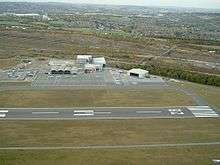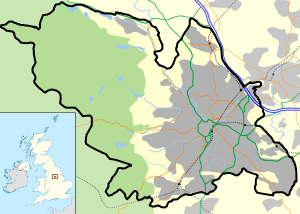Sheffield City Airport
| Sheffield City Airport | |||||||||||
|---|---|---|---|---|---|---|---|---|---|---|---|
 | |||||||||||
|
IATA: | |||||||||||
| Summary | |||||||||||
| Airport type | Public | ||||||||||
| Owner | Peel Airports and Heliports | ||||||||||
| Operator | Sheffield City Heliport Services | ||||||||||
| Serves | Sheffield | ||||||||||
| Location | Sheffield Parkway | ||||||||||
| Elevation AMSL | 231 ft / 70 m | ||||||||||
| Coordinates | 53°23′39″N 001°23′19″W / 53.39417°N 1.38861°WCoordinates: 53°23′39″N 001°23′19″W / 53.39417°N 1.38861°W | ||||||||||
| Website | www.sheffieldcityairport.com | ||||||||||
| Map | |||||||||||
 EGSY Location in Sheffield | |||||||||||
| Runways | |||||||||||
| |||||||||||
Sheffield City Airport (IATA: SZD, ICAO: EGSY) was a small airport in Sheffield; it is now closed. It was in the Tinsley Park area of the city, near the M1 motorway and Sheffield Parkway, and opened in 1997. The airport's CAA licence was withdrawn on 21 April 2008 and it was officially closed on 30 April 2008, as Sheffield City Council had approved plans to turn the airport into a business park.[1] On 22 November 2012, the South and East Yorkshire Branch of the Federation of Small Businesses launched a campaign and petition with the aim of delaying redevelopment of the airport site, and calling for the airport's potential to be reassessed.[2] Three weeks later, a mystery bidder made a bid to Sheffield City Council to reopen the airport.[3]
History
An early proposal was made in 1968 to build an airport on land near Todwick in Rotherham but came to nothing. The lack of an airport in Sheffield was (is) due primarily to the fact there is only a limited area of flat land large enough for it. In fact the size of the airport which was eventually built was determined by this geographical factor.[4] It is not coincidental that Sheffield is built on hills because the resultant rivers powered the development of its most famous industries, namely steel making and engineering.
The airport was built, after a consultants report, on a short-runway STOLPORT model similar to London City Airport. It offered flights to Belfast, Amsterdam, Brussels, Dublin, Jersey and London with the airlines KLM uk, Sabena, British Airways and Aer Arann. The Amsterdam service was described by KLM uk as the best start-up they had ever experienced.[5]
Passenger figures ranged from 46,000 in 1998, 75,000 in 1999, 60,000 in 2000, 33,000 in 2001 and 13,000 in the airports final year of operation.
It has been claimed that it was the choice of the city airport model, coming immediately before the meteoric rise of the low cost airline in the UK, that condemned the airport from the start: it was argued that Sheffield did not have enough commerce to support the sort of high-fare short-hop business flights that could use the airport. However, the success of flights between Sheffield City and Amsterdam, and the subsequent expansion of regional airlines such as CityJet, Eastern Airways and Flybe makes this debatable. It was also argued that Sheffield City Airport was unsuitable because the aircraft types used by the then-new low-cost airlines could not use the airport due to the length of its runway (which had proposed building a runway starter extension) - it was claimed that there was great demand for such services in the Sheffield area. However, the veracity of this argument has been thrown into doubt by the failure of Robin Hood Airport Doncaster Sheffield to attract such services in large numbers.[6][7] It has also been asserted that the airport did not have enough traffic to justify investing in on-site radar, and that this might have been an intractable problem. Many airlines, it is alleged, were refusing to operate into the airport due to its lack of radar - however, no evidence has been offered to substantiate this claim.
In the end the last scheduled airline pulled out in 2002, after the airport had passed into the hands of Peel Airports, who were shortly to be opening Robin Hood Airport Doncaster Sheffield airport, approximately 25 miles (40 km) away. By the time the last scheduled service was flown, the terminal interior had been converted to office accommodation. Fire and rescue cover and air traffic control staffing levels were both reduced and published procedures for instrument approaches were withdrawn, rendering the airport unattractive to the current generation of airlines which offer low-cost services with turboprop aircraft.
There has been a degree of controversy over whether there was any incentive for Peel to promote the airport. The original lease between the SDC and Tinsley Park Ltd included a reversionary clause permitting the acquisition of 80 acres (320,000 m2) of land for £1 providing, after 10 years of opening, it could be shown that the airport was financially not viable. The development is being marketed at up to £220 per square foot. The estimated worth of a business park, which is now planned, being at least £1,000,000.[8][9]
Current status
An assessment commissioned by the City Council revealed it was losing £400,000 a year and was not sustainable.[10] On 21 April 2008, the airport's CAA licence was withdrawn. The airport closed completely on 30 April 2008.[11]
The runway, as a part of the 80 acres (320,000 m2), has been sold and will be developed into the Blue Skies Business Park. A heliport at the east end of the site will stay open for use by the South Yorkshire Police helicopter and the Yorkshire air ambulance and some other small private aircraft plus there is a private air school based
In November 2012, it was revealed that passenger numbers at Robin Hood Airport Doncaster Sheffield were significantly lower than forecast. Concerned that Robin Hood Airport might not be providing the boost to the South Yorkshire economy which was originally predicted, the South and East Yorkshire branch of the Federation of Small Businesses became involved. The FSB has launched a media campaign and an online petition, with the aim of encouraging a debate on the future of both airports.
The site
The airport was built as part of a plan by the Sheffield Development Corporation to regenerate a very rundown old industrial area and to reclaim the land, which had previously been mined (coal) and was the site of derelict steelworks and waste tips. The opencast coal works were undertaken by R. J. Budge, who then planned to build the airport and business park once the site was reclaimed. The project was delayed part way through when Budge went into liquidation. The site was owned by the Sheffield Development Corporation until its demise when the asset was transferred, for no cost, to Sheffield City Council. As part of the scheme the link road was built, initially to take the coal lorries straight to the Sheffield Parkway and out to the M1. Following the completion of coal extraction and the reinstatement of the land, the link road was completed through to Tinsley. This allowed work to commence on the business park that was part of the 42 acres (170,000 m2) of land that the SDC had given to the airport's developers. The road was funded by British money given to the EU in daily contributions. and was essential to the original plan to reclaim the land. The site is between Tinsley Golf Course, the Sheffield Parkway, Tinsley Marshalling Yards and British Steel's Tinsley rolling mill. Following the financial problems of Tinsley Park Ltd, Peel Holdings bought into the airport and business park for an unknown sum.
Future
Planning permission has been granted to turn the entire site into a business park, however in December 2012, Sheffield City Council received details of a bid to reopen the airport. The unknown bidder has been confirmed by the Federation of Small Businesses as a "serious bidder", and intends to reopen the airport to scheduled UK and European destinations, flight training, air taxi and business charter services.[12]
References
External links
| Wikimedia Commons has media related to Sheffield City Airport & Heliport. |
- Sources for the history of Sheffield's Airports Produced by Sheffield City Council's Libraries and Archives
- Official site
- Council information